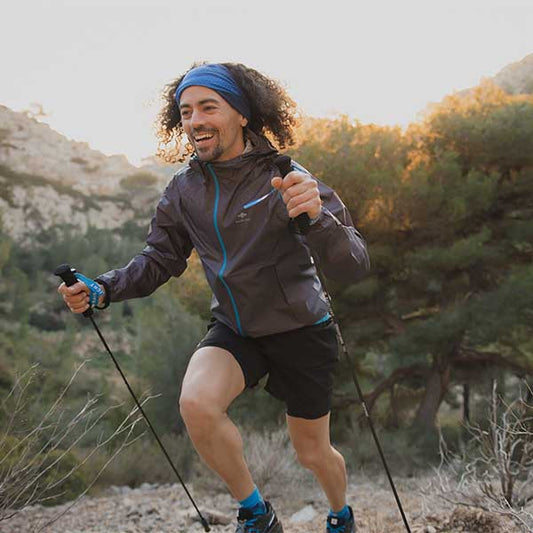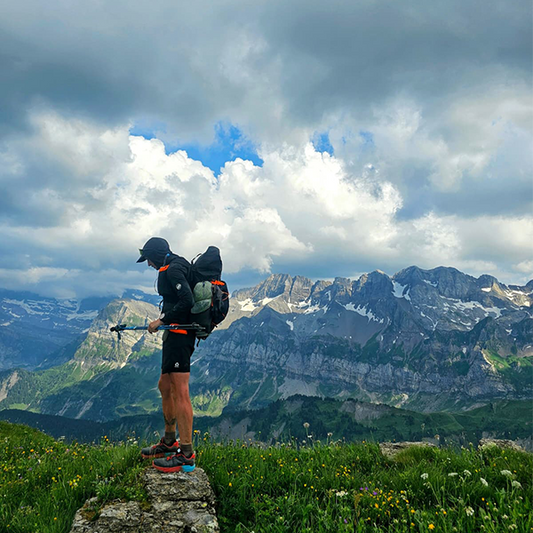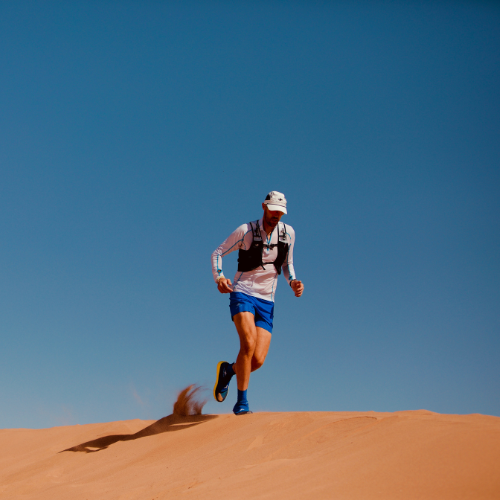If you intend to do a long trail, with rather high gradients or if youare going for long sessions in the mountains, then the use of trail poles willbe essential, whatever your level. For a trail runner, trail poles areparticularly useful for long km runs, and especially when they include bothpositive and negative gradients. They can even be essential for ultra trailraces. Trail poles are designed to help you on climbs, to save your energy, andto give you balance, stability and safety in technical passages.Pliables ou télescopiques, aluminium oucarbone, 3 ou 4 brins, choisir ses bâtons de trail peut devenir un vraicasse-tête. Suivez notre guide !
Foldable ortelescopic, aluminium or carbon, 3 or 4 sections, choosing your trail poles canbe a real headache. Follow our guide!

Length
To choose your pole length, multiplyyour height in cm by 0.67: if you are 1m80 tall you will need poles of 120cm(180 x 0.67 = 120). The size of the pole should be chosen so that the angle ofthe elbow is 90° or a little more closed when you hold the stick vertically.
Single or multi-stranded
Thesingle-stranded pole is lighter and stronger but more awkward. It also meansthat you have to run with it in your hands throughout the race.
Ifyou choose this type of pole, it is advisable to hold it upside down, in themiddle, near the balance point so as not to imterfere the swinging movement ofthe arms when not in use. The multi-strand stick is foldable, so it can bestored between uses.
Foldable or telescopic
Foldable poles are a good compromisebetween the lightness of single poles and the adaptability of telescopic poles.They can be folded in 3 or 4 parts and can be easily stored in any trail pack.This is the main attraction of this type of pole for trail runners: fast accessthanks to compact and easy storage.
Themain advantages of telescopic poles are their adaptability and robustness. Oncefolded, they can be easily stored in a trail pack. Carbonis lighter but breaks more easily and is less resistant to bending.
Carbon or aluminium
Thereare two types of metal that can be used for trail poles: aluminium and carbon, each with its advantages and disadvantages. Carbonis lighter but breaks more easily and is less resistant to bending. Aluminium is slightly heavier but stronger.
Whether you choose carbon, aluminium,single-piece or foldable trail poles, using poles for running is a fairlytechnical exercise that requires some training. With the wrong technique, arunner starting out with poles risks getting the opposite effect and losingenergy.
There are two ways to use trail poles:simultaneously or alternately. The use of one or the other depends on theinclination of the slope and the space available to put your poles.
Running with trail polesat the same time:
Simultaneous running(planting both poles at the same time) is a technique that is useful when youare on a steep incline. It takes the weight off the thighs by pushing the bodywith the strength of the arms and takes the weight off the legs on the way down.You can take several strides between each pole planting.
Running with trailsticks alternately:
The alternatingtechnique is more appropriate when there is less space available and on agentler slope. This technique requires less power and consists of alternatingright and left legs. The opposite arm plants the pole in front while the otherarm is back and in the air. In this case, it's best not to push the pole in toofar to keep a better pace. Use smaller steps for this morenatural running technique.
At Raidlight, we have chosen to meet all the needs of every trail runnerby proposing a range of trail poles made of light materials, easy to carry andto store, and designed to resist all your adventures. Our single-piece Ultralight 100% carbon trail poles (Made in France) are specifically designedfor a vertical KM or a SkyRace. Our Hybrid Carbon trail poles are versatile andadaptable to all terrains thanks to the 3 different tips (universal, snow andtrekking). Hiking, ski touring, trail, telescopic and foldable, they willaccompany you in all your activities. The Compact Z Carbon trail poles havebeen designed to optimize your trail activities and allow you to evolve in alltypes of environments. Ultralight, these trail poles are the result of abalance between aluminium and carbon for flexibility and strength.
The priority of runners for their poles is quick storage and deployment.That's why we have designed a quiver that has a forward tilting system. Morethan just a quiver, it is suitable for all types of trail poles. It also has azipped side pocket, which can easily hold a waterproof jacket for example.
Well chosen, well-adjustedand correctly used, trail poles can make all the difference during a technicalrace or an ultra-trail. However, remember to check the rules of your racebefore taking your poles with you: they are sometimes forbidden, such as in theReunion Island, to avoid accidents or to preserve protected areas.











1 comment
Picking the right trail running poles is crucial! Your tips on how to choose them are super helpful. Can’t wait to upgrade my gear and hit the trails even stronger. 🏃♀️🏞️ #TrailRunningPoles Refer to this related site https://www.kokodachallenge.com